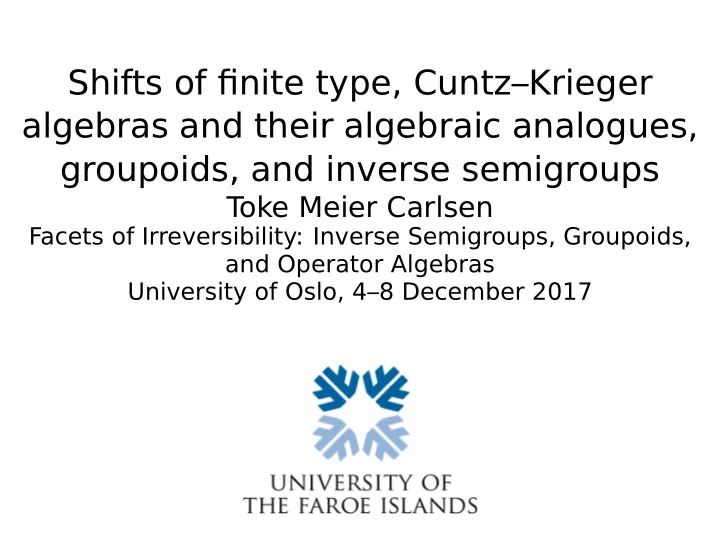

Shifts of finite type, Cuntz–Krieger algebras and their algebraic analogues, groupoids, and inverse semigroups T oke Meier Carlsen Facets of Irreversibility: Inverse Semigroups, Groupoids, and Operator Algebras University of Oslo, 4–8 December 2017
Theorem 1 Let A and B be finite square {0 , 1}-matrices with no zero rows and no zero columns, and let R be an indecomposable reduced commutative ring with unit. The following are equivalent. 1 The one-sided shift spaces ( X A , σ A ) and ( X B , σ B ) are continuously orbit equivalent. 2 The groupoids G A and G B are isomorphic as topological groupoids. 3 The inverse semigroups S A and S B are isomorphic. 4 The Cuntz–Krieger algebras O A and O B are isomorphic by a diagonal-preserving isomorphism. 5 The Steinberg algebras RG A and RG B are isomorphic by a diagonal-preserving isomorphism. T .M. Carlsen SFTs, Cuntz–Krieger and Steinberg algebras, groupoids, and inv. semigroups Page 1/5
Theorem 2 Let A and B be finite square {0 , 1}-matrices with no zero rows and no zero columns, and let R be an indecomposable commutative ring with unit. The following are equivalent. 1 The one-sided shift spaces ( X A , σ A ) and ( X B , σ B ) are eventually conjugate. 2 There is an isomorphism ϕ : G A → G B such that c A = c B ◦ ϕ . 3 There is an isomorphism ψ : S e A → S e B such that e A = e B ◦ ψ . 4 The Cuntz–Krieger algebras O A and O B are isomorphic by a diagonal-preserving isomorphism that intertwines the gauge actions λ A t and λ B t . 5 The Steinberg algebras RG A and RG B are isomorphic by a graded diagonal-preserving isomorphism. T .M. Carlsen SFTs, Cuntz–Krieger and Steinberg algebras, groupoids, and inv. semigroups Page 2/5
Theorem 3 Let A and B be finite square {0 , 1}-matrices with no zero rows and no zero columns, and let R be an indecomposable commutative ring with unit. The following are equivalent. 1 The one-sided shift spaces ( X A , σ A ) and ( X B , σ B ) are conjugate. 2 There is an isomorphism ϕ : G A → G B such that ϕ ◦ ε A = ε B ◦ ϕ . 3 There is an isomorphism ψ : S A → S B such that ψ ( S r A ) = S r B and ψ ◦ r A = r B ◦ ψ . 4 The Cuntz–Krieger algebras O A and O B are isomorphic by a diagonal-preserving isomorphism that intertwines the positive maps τ A and τ B . 5 The Steinberg algebras RG A and RG B are isomorphic by a diagonal-preserving isomorphism that intertwines κ A and κ B . T .M. Carlsen SFTs, Cuntz–Krieger and Steinberg algebras, groupoids, and inv. semigroups Page 3/5
Theorem 4 Let A and B be finite square {0 , 1}-matrices with no zero rows and no zero columns, and let R be an indecomposable reduced commutative ring with unit. The following are equivalent. 1 The two-sided shift spaces ( X A , σ A ) and ( X B , σ B ) are flow-equivalent. 2 The groupoids G A × R and G B × R are isomorphic. 3 The inverse semigroups ˜ S A and ˜ S B are isomorphic. 4 The stabilised Cuntz–Krieger algebras O A ⊗ K and O B ⊗ K are isomorphic by a diagonal-preserving isomorphism. 5 The algebras RG A ⊗ M ∞ ( R ) and RG B ⊗ M ∞ ( R ) are isomorphic by a diagonal-preserving isomorphism. T .M. Carlsen SFTs, Cuntz–Krieger and Steinberg algebras, groupoids, and inv. semigroups Page 4/5
Theorem 5 Let A and B be finite square { 0 , 1 } -matrices with no zero rows and no zero columns, and let R be an indecomposable commutative ring with unit. The following are equivalent. 1 The two-sided shift spaces ( X A , σ A ) and ( X B , σ B ) are conjugate. 2 There is an isomorphism ϕ : G A × R → G B × R such that ˜ c A = ˜ c B ◦ ϕ . 3 There is an isomorphism ψ : ˜ A → ˜ S e S e B such that ˜ e A = ˜ e B ◦ ψ . 4 The stabilised Cuntz–Krieger algebras O A ⊗ K and O B ⊗ K are isomorphic by a diagonal-preserving isomorphism that intertwines the actions λ A t ⊗ id K and λ B t ⊗ id K . 5 The algebras RG A ⊗ M ∞ ( R ) and RG B ⊗ M ∞ ( R ) are isomorphic by a graded diagonal-preserving isomorphism. T .M. Carlsen SFTs, Cuntz–Krieger and Steinberg algebras, groupoids, and inv. semigroups Page 5/5
Recommend
More recommend